

Thomas Cooper Library Now Hiring Part-time Student Help For Spring 2018 Days/Nights/Weekends! Apply Online! library.sc.edu/employment 803-777-3145 INTERESTED IN GETTING INVOLVED WITH G&B? EDITOR-IN-CHIEF sagandbe@mailbox.sc.edu CREATIVE DIRECTOR gandbart@gmail.com ARTICLES EDITOR gandbwriting@gmail.com PHOTO EDITOR gandbphoto@gmail.com STYLE EDITOR gandbmoda@gmail.com WEB EDITOR gandblog@gmail.com PUBLIC RELATIONS DIRECTOR gandbpublicrelations@gmail.com WANT MORE FROM GARNET & BLACK MAGAZINE? CHECK OUT OUR ONLINE CONTENT AT: GANDBMAGAZINE.COM FACEBOOK.COM/GARNETANDBLACK TWITTER: @GARNETANDBLACK INSTAGRAM: @GARNETANDBLACK ISSUU.COM/GARNETANDBLACK
STUDENT MAGAZINE OF THE UNIVERSITY OF SOUTH CAROLINA
EDITOR-IN-CHIEF
CREATIVE DIRECTOR MANAGING EDITOR
ARTICLES EDITOR Caroline Fairey
ASSISTANT ARTICLES EDITOR Zoe Nicholson
STAFF WRITER Christian Compton
STAFF WRITER Sarah Nichols
COPY CHIEF Madeleine Vath
ART DIRECTOR Ashlyn Murphy
STAFF DESIGNER Gracie Newton
STAFF DESIGNER Angel Prater
ASSISTANT STAFF DESIGNER Grace Steptoe
STAFF ILLUSTRATOR Wanda Felsendhart
PHOTO EDITOR Christian Hinty
ASSISTANT PHOTO EDITOR Olivia Griffin
STAFF PHOTOGRAPHER Evan Delp
STAFF VIDEOGRAPHER Courtney Duncan
STYLE EDITOR Clara Marzolf
ASSISTANT STYLE EDITOR Alex Finley
ASSISTANT STYLE EDITOR Caroline Hart
PUBLIC RELATIONS DIRECTOR Abby Bickel
PUBLIC RELATIONS ASSISTANT Mark Maddaloni
WEB EDITOR Robin Hendricks
ASSISTANT WEB EDITOR Abby Beauregard
SOCIAL MEDIA COORDINATOR Savannah Trask
SOCIAL MEDIA DESIGNER Ashlyn Jackson
ONLINE EDITOR Courtney Carrick
ONLINE EDITOR Mary-Bryant Charles
ONLINE EDITOR Lexi Hill
BRENNAN BOOKER
RACHEL JOHNSON
EMERY SMITH
DIRECTOR OF STUDENT MEDIA
Sarah Scarborough
CREATIVE DIRECTOR
Edgar Santana
SOCIAL MEDIA MANAGER
Sydney Patterson
FACULTY ADVISOR
Scott Farrand
CREATIVE SERVICES
Wanda Felsenhardt
Ashlyn Murphy
Meagan Sigmon
Grace Steptoe
ADVERTISING REPRESENTATIVES
Jolie Delia
Katie O’Boyle
Erin Lee
Spencer Lee
Torey Powers
Drew Thiel
Cameron White
Advertising: (803) 777-3018
To contact G&B, email sagandbe@mailbox.sc.edu or visit www.gandbmagazine.com Garnet & Black magazine is produced four times a year by students of the University of South Carolina and is distributed free to members of the university community. All editors and staff members can be contacted at (803) 777-1149. The office is located in Russell House room 339. Email letters to the editor to sagandbe@mailbox.sc.edu or to Garnet & Black magazine, Student Media, 1400 Greene Street, Columbia, SC 29208. Letters should be 250-400 words and must include name, address, phone number and academic information (if applicable). Garnet & Black reserves the right to edit for libel, style and space. Anonymous letters will not be published.
Contents Garnet & Black Magazine Spring 2018 THE FOLLOWING ARE THE CONTRIBUTORS WHO HELPED IN THE PRODUCTION OF THS ISSUE: JESSICA BLAHUT, ZACH FREHSE, ANNA SHEPPARD, KATIE SLACK, RICHARD VOLTZ
THE
Meet
FIGHTING
09
DEFENSE OF FANFICTION
the narrative. 26
FIFTIETH STATE
time to stop thanking Mississippi. 53
FOR LONELY RIVER
poetic meditation
WHILE I HAVE THE FLOOR Athletes speak about the mat and the screen. 10
OTHER “F” WORD Workplace woes for the modern woman. 30
IN
Reframing
THE
It’s
AUBADE
A
by Anna Sheppard.
THE
PLACE
Tapp’s new space is impacting Columbia’s community. 55 HALF-HOMEMADE
you should fill your mini fridge with. 14 DICHOTOMY Vice and virtue style. 34 IN TIME
50 SLEEP 101 Leave naps during class behind you for good. 16 SHOT GIRL A student, a strip club and what she learned. 42 IN THE DARK There’s more to a name than you think. 18
I KNOW A
How
What
Fiction by Robin Hendricks.
FIRE WITH FIRE
46
Managing the First Amendment at USC.
IMPOSTER EXPERIENCE
your own worst critic. 22
Weekly
48
A SOUND OF THEIR OWN Discover
doesn’t tell you everything.




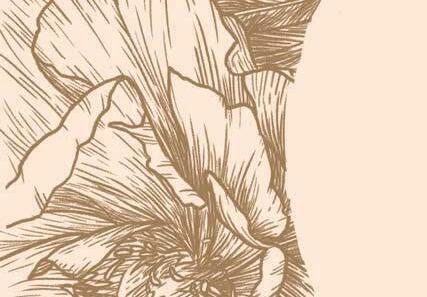
















































































Letter from the Editor
EDITOR-IN-CHIEF BRENNAN BOOKER

THE BEGINNING OF A YEAR is always the worst for me. The pressure of another 365 days feels almost punishing. I find myself worrying about what is to come, desperately attempting to mold my future into what I want it to be. Instead of focusing on the anxiety the future brings to myself and many of us, I have found emotional reconciliation in reflecting on the past.
I think the toll 2017 took on us can’t be put into words. We faced fear and hate on a scale that for many of us was completely unprecedented. Never in my own life had I felt that I lived in a world so divided. Day after day, it seemed like nationwide we were drifting apart from each other, losing sight of the humanity that defines us. We have been in a constant state of finger-pointing, blaming the “others” from across the divide.
It is our duty to fight this current climate. This issue we strove to examine, dissect and critique the world that surrounds us. The words across these next pages serve to ask questions in pursuit of not only knowledge, but also empathy. From understanding the role of women in the workplace, whether in a Fortune 500 company or a strip club, to the impact of quality education for young students in our state. Ultimately, empathy is what will drive us forward in 2018 — to understand the struggles and experiences of our fellow person.






Supporting the vision of a Healthy Carolina community @UofSCshs Student Health Services is an accredited Patient-Centered Medical Home Student Health Services TAKE CARE. Let 2018 be a year of taking care of yourself; mind, body & spirit. Stay informed about the ways Student Health Services can help.
sa.sc.edu/shs/takecare
In Defense of Fanfiction
If you can’t beat them, rewrite them.
BY ZOE NICHOLSON • ILLUSTRATION & DESIGN BY WANDA FELSENDHART
“I WAS IN THE MIDDLE before I knew I had begun.” Mr. Darcy’s sentiments about his love for Lizzie in Jane Austen’s classic “Pride and Prejudice” accurately portray my relationship with fanfiction, and I would venture that it’s true for most people who dare to venture down this literary rabbit hole.
People love to see themselves represented in pop culture. It is why we sort ourselves into Hogwarts houses, watch season after season of “Grey’s Anatomy” and cry when listening to that one Frank Ocean song (he just gets it). But for a lot of people, especially the queer community, it is hard to see themselves represented in mainstream media.
To combat the lack of representation, young queer writers began to write slash fanfiction — a subset of the genre specifically created to write LGBT+ storylines into popular books, movies and television shows — back

when Kirk and Spock were still gracing televisions in the ‘70s. The popularity of slash is phenomenal and cannot be ignored.
With thousands of storylines drawing on everything from Naruto to One Direction, writers began to create stories they identified with into narratives we straight people have been identifying with since the dawn of literature. They are writing passionate, complex and fully fleshed out relationships within mainstream stories. Authors and bibliophiles alike may scoff at the “inherently amateur” nature of fanfiction, but a lot of it is actually good and extremely popular.
One slash piece by writer ivywoman63 on popular fanfiction site Archive of Our Own is about a pre-existing lesbian relationship on the CW show “The 100.” Published less than a year ago, the 20-chapter fanfic has already garnered more than 35,000 hits, more views than many
published novels receive. One of the most popular works on the entire site, a Harry Potter/ Draco Malfoy slash by Starlight_massacre, has more than 337,000 hits. So maybe the representation isn’t quite there in mainstream media, but an audience certainly is.
By literally taking control of the story, slash writers are not asking to see something meaningful; they are just doing it themselves. And while the genre has a long way to go to garner more acceptance in the literary community — it is hard to take something seriously when it includes biblical fanfiction — the impact and resonance slash has with LGBT+ people is reason enough to give it its own space in mainstream culture.
So go read some fanfiction; you might find something that you connect with — as long as it is not “Supernatural” brocest.
OP-ED 9
WHILE I HAVE

10 WHILE I HAVE THE FLOOR
THE FLOOR
This interview is the third installment of While I Have the Floor, a series focused on giving different student groups a platform for thoughtful discussion on issues of politics, religion and culture. This issue, we’re here with Dylan Schoonmaker, fundraising chair for the Gamecock Wrestling Club, and Micah McIlhenny, e-gamer at the university, to discuss what it means to train, compete and take part in unique and unconventional sports.
BY COURTNEY CARRICK • PHOTOS BY MARK MADDALONI • DESIGN BY ASHLYN MURPHY
What is going on in the realm of your sport, on a personal level and in the larger world?
SCHOONMAKER: As far as our team is concerned, we just had a tournament in Tennessee this past weekend. We only had six guys compete though, because it was the first weekend back and a lot of us are rusty. We are sending a great group of guys to Charlotte for a tournament in early February and are going to bring back some wins.
As for the greater community, I feel there is a huge untapped potential in media exposure for wrestling. A lot of people don’t know, but club wrestling alone is in schools all over the country. Our school doesn’t have a NCAA program, so the club is really all we have when it comes to wrestling. When you think of college wrestling a lot of the time you might think of the big NCAA picture, but nobody really knows about club wrestling.
MCILHENNY: With e-gaming, it’s often easier to explain by starting large and working down from there. Right now, USA and Japan are primarily the biggest competitive gamers. The games that are played competitively can vary from country to country and almost always overlap somewhat, but Asian countries tend to be more invested in competing in MOBAs (Multiplayer Online Battle Arenas), like Dota 2, League of Legends and Heroes of the Storm. The USA teams love competitive shooters like Call of Duty and Halo. Those two types of games, MOBAs and shooters, are really the two types of games being played competitively on an international level.
On a smaller scale, most games now have ranking systems, so you can play competitively even if you aren’t on an official team or clan. Personally, I play almost exclusively MOBAs when playing competitively. Competitive gaming on a smaller scale is finally starting to rev up as more people are beginning to see gaming as a sport. Slowly but surely.
How does teamwork play a role in your sport? What about individuality?
MCILHENNY: Within the gaming community, there is a misconception that one person can carry the whole team. That’s not the case. If you don’t know your teammates and how to communicate with each other you’re going to be at a huge disadvantage. Individuality can aid your team, if you’re using it for that purpose, but being a lone wolf doesn’t typically work out very well.
SCHOONMAKER: There is a lot of individuality in wrestling, because you wrestle at your weight against one other person, and it’s just you two on the mat. There is definite teamwork behind the scenes in wrestling though, because during practice you rely on your teammates to push you. It helps a lot when you are at a dual meet and its team-vs-team to have your whole team there with everyone cheering you on as you’re out on the mat. Sometimes they will be yelling stuff you can do that you’re not picking up on yourself. But when you’re at an individual tournament, some guys might be
11
wrestling on other mats, and it’s a lot more solo. You’re on a team, but because of weight classes, it is a lot more individual.
MCILHENNY: I would say the equivalent to weight classes in video games would be the various team positions. With MOBAs, you typically have someone who plays a rangedmid, you have an attack-damage carry, either an ability-power or mage-carry, a healer-support, and then typically a stealth or assassin. Each teammate is in an individual class, but we need each other “on the mat with us,” so to speak.
Do you feel your sport is viewed differently from other sports?
SCHOONMAKER: Wrestling is definitely viewed differently, even in outward appearance. Almost every other sport you look at and see people wearing jerseys, but with wrestling we just have our singlets. So, a lot of people just see two guys in tight singlets rolling around on the mat rather than seeing a really unique sport that involves a lot of technique and endurance. I may be biased in saying it is one of the tougher sports out there, but I’m not biased in saying wrestling doesn’t get the recognition it deserves. You have to make weight, which requires you really watch what you’re eating. It’s not as simple as working out, being in good shape, and going out onto the field and practicing.
MCILHENNY: Yes, gaming is totally viewed differently from other sports. Probably because gaming doesn’t have a lot of physical activity involved and people just think of it as a lazy activity. Only in the past few years have e-sports started gaining recognition as a sport in general, but a lot of people still don’t acknowledge the competitive gaming community. People don’t think “sport” when they think e-gaming, but it’s competitive and requires strategy, teamwork, and preparation. People say it’s not a sport because you’re not moving, but there is more that goes into e-gaming than pressing a button and grabbing the controller.
What do you think is the greatest misconception about your sport?
SCHOONMAKER: A lot of people make jokes about wrestling because of the surface judgments they make. People will often focus on how tight or small our singlets are — or that we are guys wrestling each other — and try to make it something it’s not. Others will say things like, “Oh, so you don’t like eating?” just because we really have to focus on making our weight class. I love to eat though; it’s one of my favorite things. I just go into every competition thinking, “Do I want to win this fight or do I want to lose?” If I let misconceptions about wrestling get to me, I would be missing out on a unique sport that has helped me grow as a person on so many levels.
MCILHENNY: I think people immediately think of a middle-aged man in his mom’s basement when they hear about competitive gaming. People think gamers don’t take care of themselves or can’t keep up their grades. Just like with any sport though, you have to take care of yourself to really be at your best. You have to get enough sleep, stay healthy, make sure you’re balancing the time on screen with time off-screen. I’ve also heard competitive gaming doesn’t require as much time and effort as physical sports, but when I am preparing for a competition I will practice hours each day. Video games may be less physically demanding, but they’re just as mentally demanding. They require a lot of spatial strategy, observation skills and constant communication with your team. It takes time, practice and dedication.
What valuable skills have you developed that assist you in the outside world?
SCHOONMAKER: Just this year, I took on the role as fundraising chair, so I have to reach out to different programs that can potentially bring in money for our team. That’s not something I am used to at all. I am an introvert by nature, but I’ve been having to talk to a lot of people. It’s really made it
a lot easier to communicate with people, especially when that was something I was never really great with before.
MCILHENNY: Believe it or not, communication skills. When you play games online, especially competitively, you end up playing with or against a lot of people from different countries. It can bridge cultural gaps and expand your understanding of what communication means. It’s cool when you meet people online and then can apply the same skills to meeting people in real life.
Where do you hope to see your sport or organization in the future?
SCHOONMAKER: This is my last season wrestling because I’m about to graduate. A couple other board members and myself are talking more and more about fundraising. Our goal is to make this program bigger as well as better funded. We are hoping to bring in money for better equipment like singlets, shirts, gear and especially mat tape. I hope our wrestling club grows so that we have a solid group of 30 people, because some of our problems last year when competing were due to not having a full team. For example, we would have beat Clemson’s wrestling team last year if we hadn’t been forced into forfeiting our empty weight classes.
MCILHENNY: E-sports being funded in the way other national sports are is something I would really love to see. Most major league gaming is privately funded, and that doesn’t give competitive gaming as much recognition as it needs. It makes competitive gaming an outsider in the sports world. I’d really like to see e-gaming grow to a point where it is recognized as a sport nationally, and eventually internationally.
12
“I THINK PEOPLE IMMEDIATELY THINK OF A MIDDLEAGED MAN IN HIS MOM’S BASEMENT WHEN THEY HEAR ABOUT COMPETITIVE GAMING.”

13
“IF I LET MISCONCEPTIONS ABOUT WRESTLING GET TO ME, I WOULD BE MISSING OUT ON A UNIQUE SPORT THAT HAS HELPED ME GROW AS A PERSON ON SO MANY LEVELS.”
Half-Homemade
Tips for stocking your pantry, homemaking away from home and making your parents proud.
BY LEXI HILL • PHOTO BY BRENNAN BOOKER • DESIGN BY JESSICA BLAHUT
Living off-campus often means swapping your student meal plan and all of the food campus eateries such as Russell House have to offer for home-cooked meals. After a year of ready-made options, many students are left wondering where to even begin. If you’re new to off-campus living, here are three tips to stocking your pantry for success.
Plan Ahead
One of the most common pantry-stocking mistakes students make is buying too many snacks and not enough ingredients for actual meals. No, peanut butter and jelly sandwiches and Ramen do not constitute meals. To combat this faux pas, plan out your meals at the beginning of the week, so when you do get to the grocery store, you know exactly what you need. For example, an easy meal to rely on for most is grilled chicken, a vegetable and whatever starch you prefer (sweet potatoes, pasta — you get the idea). Planning makes meal time that much easier!
Stock Up on Favorites
If planning is near impossible for you, then opt for bulk packaging instead. This way, when you’re in a rush, you’ll have at least something to grab on your way out the door. Great examples of this are protein bars, snack-sized treats packed in Ziplock bags or pre-made microwave meals. Be careful you’re not relying too heavily on high carb or high fat snacks, though. One way to avoid this is by making your own trail mix or throwing in your favorite vegetables or fruits for easy snacking throughout the day.
Keep Spices Around
Seasoning is the holy grail when it comes to food prep, but chances are, if you’re new to living off-campus, you didn’t even think twice about the spices you needed for your pantry. Simple additions like salt, pepper, oregano, cayenne and granulated garlic make every meal taste better. Plus, kitchen snapshots are trending on Instagram, so buying a trendy spice rack might even get you more likes on the social media sharing platform.
14 FOOD
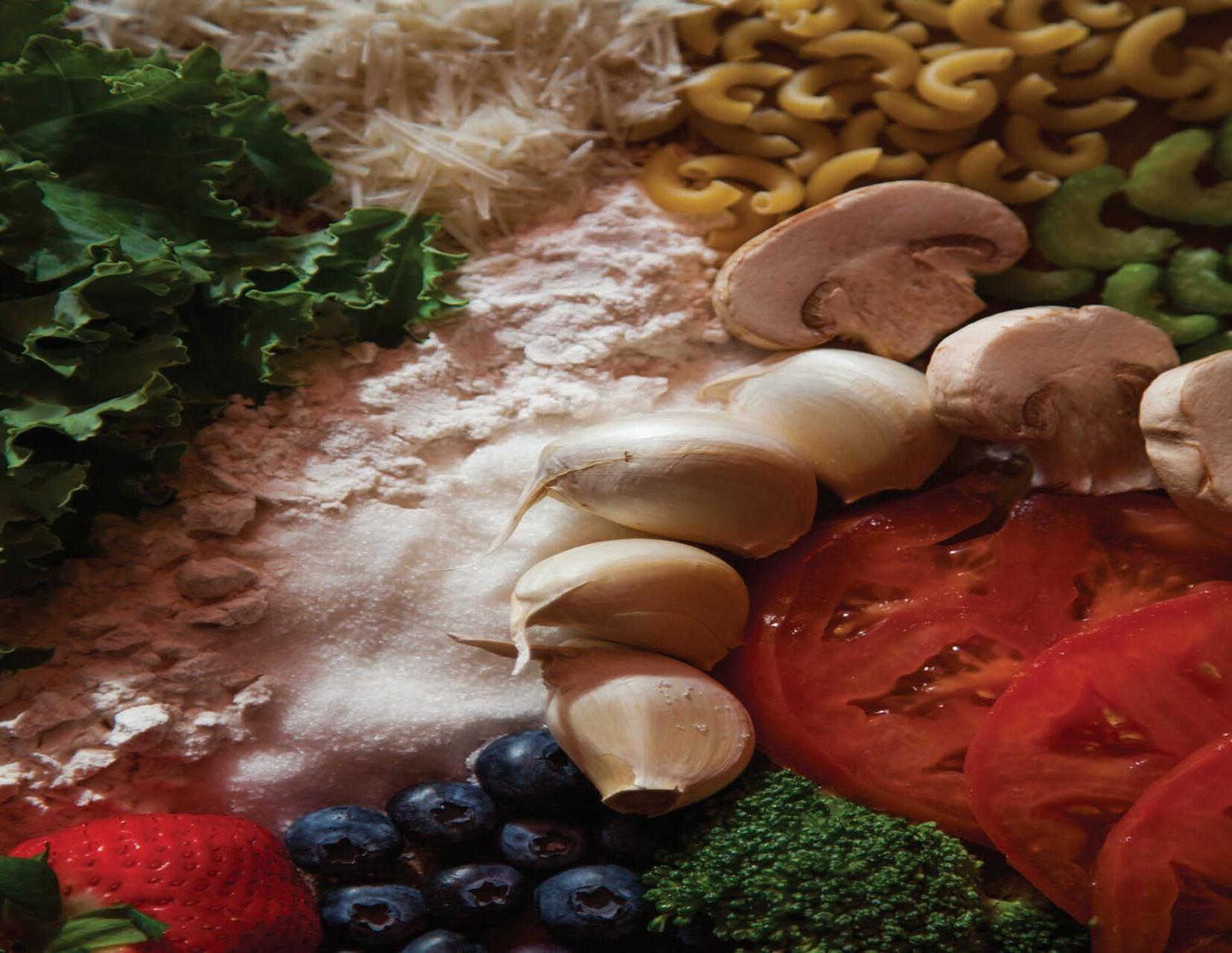
 BY CHRISTIAN COMPTON • PHOTOS BY EVAN DELP • DESIGN BY ANGEL PRATER
BY CHRISTIAN COMPTON • PHOTOS BY EVAN DELP • DESIGN BY ANGEL PRATER
It probably comes as no surprise to most USC students that a 2014 study sponsored by the NCBI found that 50 percent of college students experience daytime sleepiness and another 70 percent were found to get an insufficient amount of sleep.
For many on campus, balancing the academic and social expectations of campus along with self-care and attaining a sufficient amount of sleep is a task that is impossible to satisfy. Nevertheless, sleep scientists say that there are a few options for improving the quality of your sleep that may be easier to do than simply trying to get more.
For starters, experts say that recognizing what your average quality of sleep is should be your first step in making any changes. “It’s always tough getting out of bed in the morning, but once I am up, I feel pretty refreshed and ready for the day,” says Jacob King, a freshman who lives on campus in a residence hall. King added that he thinks his overall sleep quality is “very good.”
Still, hours spent in bed alone are not enough to keep you going during the day. Research has shown that getting the target seven hours of sleep may only be part of the picture — sleep hygiene, as it is coined, is more significant in most cases. Sleep hygiene refers to a number of factors that affect the overall quality of sleep.
Improving your sleep hygiene can be accomplished in several ways. Experts recommend, for example, avoiding stimulants like caffeine close to bedtime. Certain foods, especially those
that are fried or spicy, can also disrupt sleep if consumed too close to laying down. Research has shown that people who exercise regularly generally have better levels of sleep hygiene as well as a more consistent sleep schedule altogether. It is cautioned, however, that you do not exercise too close to going to bed, as the energy spike can prevent sleep from being restful. Light exposure is also a key factor. Research has shown that excessive blue light exposure (the type of light emitted from phones and computers) prior to laying down can greatly interfere with the production of melatonin, the hormone that helps control your sleeping and waking cycles. Allowing natural light into your room in the morning may also help wake you up gently, but more importantly, limiting your exposure to blue light from electronic devices at least an hour prior to going to sleep is essential. Experts warn that while you may be able to fall asleep right after you lock your cell phone, the sleep you are getting is not as restful as sleep that isn’t mired with blue light exposure. This also means that televisions in the room should be turned off prior to sleeping. While many assert that the television helps them sleep, the same principle above applies here: blue light exposure will greatly reduce the quality of the sleep you get. Your body operates based on an internal clock known as your circadian rhythms. Essentially, this clock programs itself to operate based on when you go to sleep and when you wake up. Thus, consistency is
the number one key to restful sleep — that is, going to sleep at the same time every night and waking up at the same time every morning. This means skipping the temptation to sleep in on the weekends, although some have posited that it is possible to repay some of your sleep debt by snoozing for a few hours longer on the weekend. For many college students, however, such consistency is impossible due to class scheduling. After all, nobody wants to get up any earlier than they must. Nevertheless, experts say going to bed and waking up at the same time every day of the week is considered to be one of the single most powerful ways one can improve their overall sleep hygiene. But what about if you can’t do any of these things, and you feel tired during the day? Hours of sleep missed contributes to a running sleep debt which some researchers say cannot be paid back. Many attempt to supplement a lack of restful nighttime sleep via napping, but the unfortunate truth is that napping for longer than periods of thirty minutes actually interferes with your ability to sleep at night. Even worse, hours regained through napping do not actually pay anything on your sleep debt — so napping irresponsibly is even worse than skipping the nap altogether. While altogether, sleeping the proper way may seem like an impossible task, even adhering to just one of the recommendations given by sleep experts can go a long way in reducing daytime sleepiness and the temptation to doze off in class.
HEALTH & WELLNESS 17
A guide to feeling rested after rest.
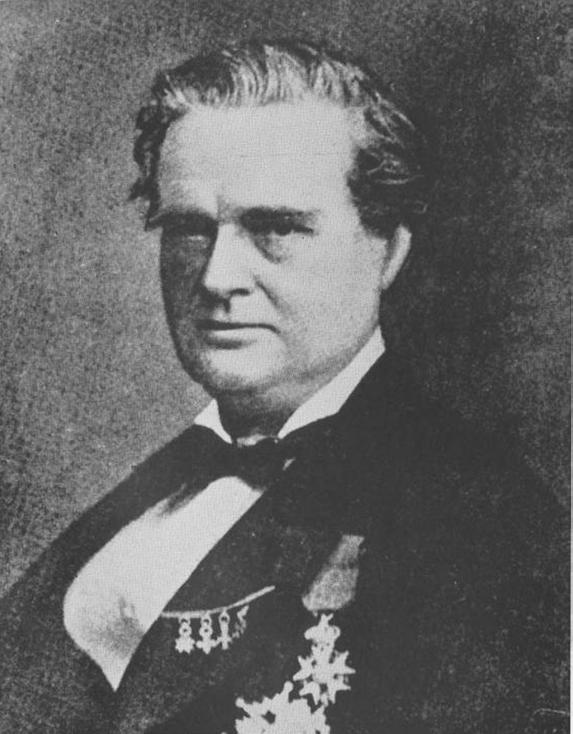
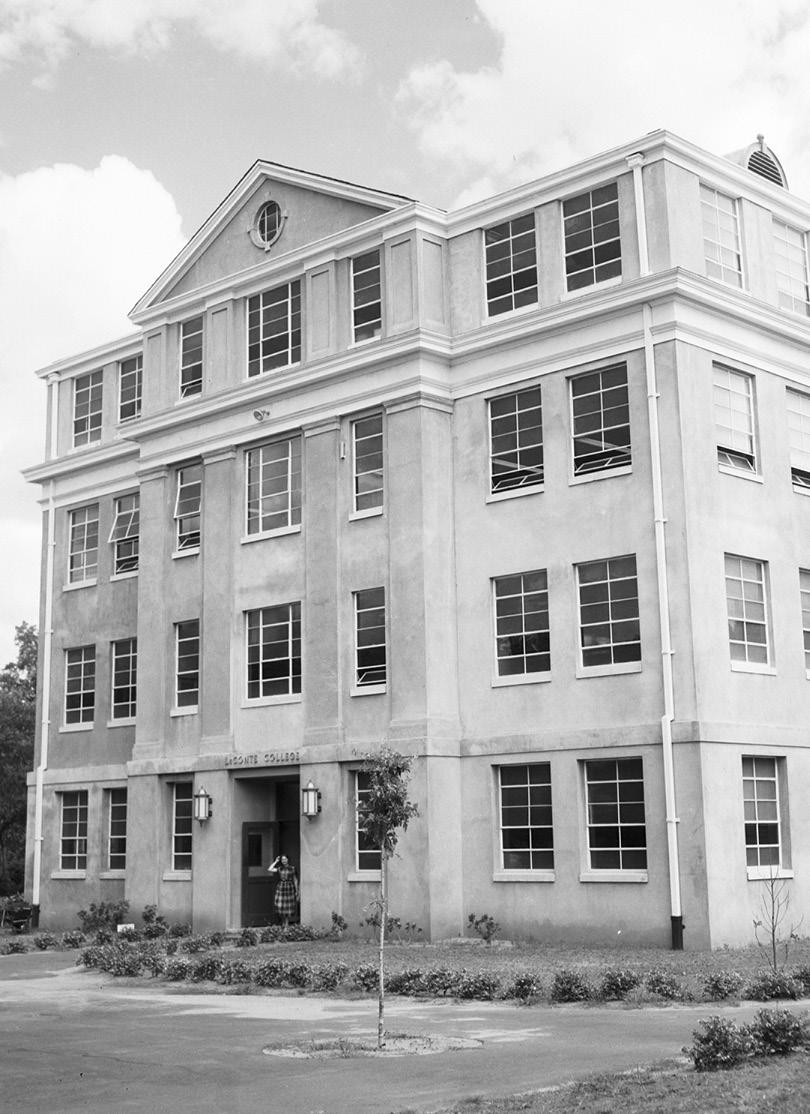
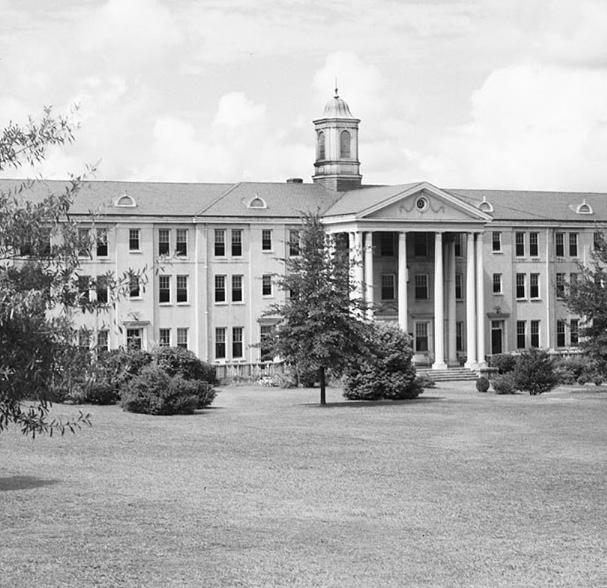
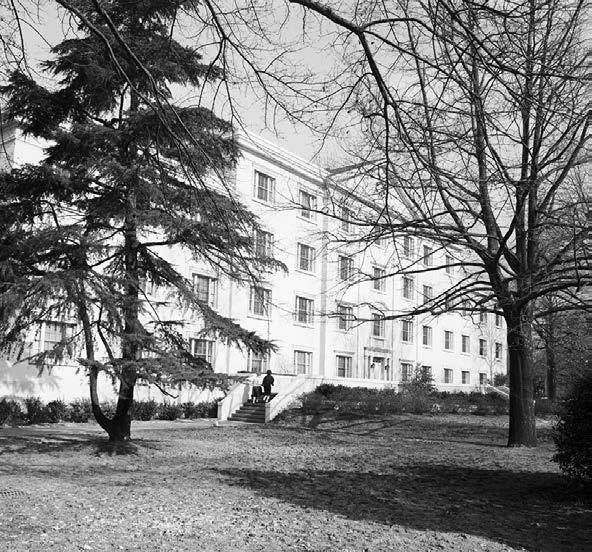
DARK IN THE
BY CAROLINE FAIREY • PHOTOS BY MARK MADDALONI • DESIGN BY ASHLYN MURPHY
AFTER THE CIVIL WAR, Joseph and John LeConte left South Carolina College for California. They were outraged with the newly enforced laws of the post-Civil War state legislature that allowed newly freed slaves to attend the university. Today, their name adorns the math and statistics building.
Evidence of a past riddled with racial discrimination and violence is littered around our campus and adorns our buildings. Just last month, a racist message to the black community was posted on the welcome board for the Center for African American Studies, prompting campus-wide outrage and reigniting the discussion for accountability and justice in the face of racism.
“I think the campus generally operates in the dark about the history of places on our campus,” USC professor Bobby Donaldson says. “Rarely is it even brought up for any discussion.”
Last year, Yale University asked both students and faculty to engage in this difficult discussion. Calhoun College was renamed
due to South Carolina politician and Yale alumnus John C. Calhoun’s reputation as a secessionist and white supremacist. The conversation at Yale wasn’t about educating students and faculty on Calhoun’s legacy and moral code, but rather whether it matched up with Yale’s — it did not.
Donaldson doesn’t think USC needs to take the same route as Yale. “There needs to be a more thorough history of the names of places on campus before we make a decision about renaming,” he says.
Even if the university wanted to change the names of buildings, they could not. The South Carolina Heritage Act, passed in 2000, ensures that “no street, bridge, structure, park, reserve, or other public area of the state dedicated to, in the memory of, or named for any historical figure or historical event may be renamed or rededicated.” This is why university archivist Elizabeth West wants to educate the public instead of eradicating these histories.
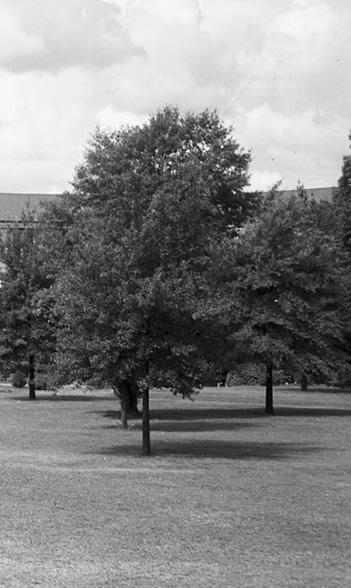
FEATURE 19
The men whose names haunt our buildings.
Sims is a national figure. The state health department is named for him, and his statue sits on the State House grounds and in New York City, where he practiced medicine for most of his career.
The Washington Post reported on the fight to remove Sims’ statue in New York City after alt-right protests in Charlottesville this summer sparked activists to look into the historical figures dotting our public places. Columbia Mayor Steve Benjamin told Chris Matthews that the Sims statue on the State House grounds offends him more than any Confederate memorial.
“Why was an all-women’s dorm named after a very prominent male slave owner?” Donaldson asks. Two of the dorms making up women’s quad are named for such men: Sims and Wade Hampton. Sims was not only a slave owner, but also a physician who performed on non-consenting slave women he kept in a locked building connected to his workroom. His lab rats were “on loan” from fellow slave owners.
The dormitory was constructed and dedicated in 1939. “At the time, they (the Board of Trustees) didn’t think the female graduates — who started attending the university during the 1890s — had the prominence that some other alumni did,” West guesses at the board’s choice.
Randall pushes for education, especially on the most off-putting building names. Signage and education “serves as a reminder that many of our buildings on campus are named for people we should not blindly laud,” she says. Sims, a man who thought himself to be a hero, has now come to be known as a cruel scientist. Without admitting his transgressions and refusing to acknowledge the atrocities he committed, we regard Sims as the hero.
Thomas Cooper was an abolitionist-turned-slavery defender who introduced South Carolina to the idea of states’ rights and nullification. Today, we spend hours in the sprawling library named after him.
Looking ahead, the South Carolina Heritage Act greatly hinders the chance to change building names, but Donaldson offers an alternative: “We need a new interpretation of these places, of these people.” But if the recent additions to the Horseshoe are any indication (the plaques commemorating enslaved men and women who built South Carolina College),
the university’s attempts may not be as complete as some would wish. Nonetheless, the first step is acknowledgement, which the administration has begun to do.
Only three buildings on campus are named for women: the Darla Moore School of Business, McClintock Hall, and Russell House, which was named for the former USC president and his wife. Only one is named for a person of color: Booker T. Washington. In the next phase of expansion, the university should cast a wider net outside of its usual pool and look for people who truly represent the diverse university we have evolved into, like George W. Murray, a prominent civil rights activist who was born a slave and died a respected senator and educator.
But if the past year has taught us anything, it’s that facing the ugliness of the truth is vital to progress. The Silence Breakers told their stories of assault, the immigration bans and talks of a Mexican Wall found people across the country opening their arms to immigrants and refugees, and the vile face of white nationalism in Charlottesville and across social media has prompted another fight for equality and justice.
Sen. Strom Thurmond was a longtime senator and Dixiecrat who passionately fought to stop the 1957 Civil Rights Bill and known sexual harasser. Today, his name sits upon one of the largest fitness and wellness centers on any American college campus.
“ Things like this tend to build in different areas of the campus, and then they all hit the right moment with student involvement,” West says. The recent push by students and faculty, especially the 2020 Vision team, have forced administration to address the issue.
It’s time to confront the past. Not to rewrite it, but to acknowledge the ugliness of what these men did, so we can start a dialogue about how we — the students, the faculty, the university, the state, the nation — can move toward a future that is not clouded by the sins of our past.
20
THANK YOU TO UNIVERSITY ARCHIVIST ELIZABETH WEST FOR HER INVALUABLE HELP ENSURING HISTORICAL ACCURACY AND PROVIDING THE HISTORICAL PHOTOGRAPHS.
“NO STREET, BRIDGE, STRUCTURE, PARK, RESERVE, OR OTHER PUBLIC AREA OF THE STATE DEDICATED TO, IN THE MEMORY OF, OR NAMED FOR ANY HISTORICAL FIGURE OR HISTORICAL EVENT MAY BE RENAMED OR REDEDICATED.”

21
Two students step up to say what everyone else has been thinking.
BY CHRISTIAN COMPTON • PHOTOS BY OLIVIA GRIFFIN • DESIGN BY ANGEL PRATER



In Fall of 1978, Psychotherapy Theory, Research and Practice published an article written by Pauline Clance and Suzanne Imes of Georgia State University. The paper focused on a group of women with a number of achievements to their name who, “Despite outstanding academic and professional accomplishments, … persist in believing that they are really not bright.” To describe these women, the authors coined the term “imposter phenomenon.”
The paper documents many women in high positions in academia who feel that they do not belong in their positions, and that their elevation to their positions was either due to someone being kind to them or them fooling people into believing they are more qualified than what they actually are.
The imposter phenomenon, it turns out, is not actually a mental disorder of any sort (even though it’s commonly called “imposter syndrome”), nor is it something that only affects women as was initially theorized (follow-up studies into the matter showed that it’s equally likely to affect men, but men are less likely to acknowledge it). In fact, Clance told Slate magazine in 2016, “If I could do it all over again, I would call it the imposter experience, because it’s not a syndrome or a complex or a mental illness, it’s something almost everyone experiences.”
Instead, it’s a phenomenon experienced at least once by almost 70 percent of people, according to a 2011 academic paper in the International Journal of Behavioral Science. Iconic individuals from Tom Hanks and John Green to Sonia Sotomayor and Maya Angelou have talked about their experiences with the
phenomenon, with the latter famously saying “I have written 11 books, but each time I think, ‘Uh oh, they’re going to find out now. I’ve run a game on everybody, and they’re going to find me out.’”
The phenomenon manifests itself in many forms, ranging from a tendency to dismiss or deflect compliments about one’s achievements, to outright denying the significance of one’s own accomplishments.
This pattern of thinking, unfortunately, is not broken by achievement. In fact, it seems that no matter how much an individual achieves, they may find themselves prone to feelings of being a fraud or a simple inability to see their accomplishments as being significant. In some cases, the more one achieves, the more anxious they become as they worry that they will be “exposed” as an imposter.
“I don’t know that I would call myself successful because I feel that I have not succeeded in completing anything in particular,” a top scholar who asked to remain anonymous said. In spite of this, this student has an impressive list of achievements: in addition to being in the Honors College, she is pursuing a double major in statistics and computer science. She is also a part of computing organizations on campus, is musically inclined and writes for a campus publication.
Many would look upon this list of achievements and be willing to make the case that this top scholar is, indeed, successful. The top scholar acknowledged that some people may call her “smart,” but said that she doesn’t believe it. “If anything, I’m just a person who works hard at pretending to be smart, and I think that a lot of people have the capacity to do that too,” she said.
FEATURE 23
She is by no means alone in this regard. Another student — a junior in the International Business program and Chinese Enterprise cohort — who asked to remain anonymous expressed similar sentiments. The IB student also spent his sophomore semester abroad, in addition to other academic achievements. “I frequently dismiss compliments and question whether I am truly deserving of praise,” he said, mirroring many of the sentiments expressed by the top scholar. “My accomplishments, as I see them, could just have easily been achieved, and in fact have been, by many others,” he said.
The saying goes that comparison is the thief of joy, but both the top scholar and the IB student disagreed, saying that while sometimes burdensome, the tendency to compare to others can also provide a source of motivation.
I think it’s only natural that when a group of people who achieve highly are put in one place, they will all wonder if they’re good enough because they all feel like there’s someone else better than them,” the top scholar said, referring to the Honors College. “That anxiety of not being good enough is what drives me to be more ambitious, and even though it can be
unhealthy sometimes, without it, I don’t think I’d be as passionate about my goals as I am today.”
The IB student noted that comparing yourself to others is not always the best approach. “There is always going to be something better, someone that may have a higher-paying job or social standing. The grass is always greener on the other side,” he said. “If you go through life comparing what you have to others, you won’t be happy.”
Nonetheless, even acknowledging these things, it can still be a challenge for those enduring the imposter experience to keep their inner voice from becoming an inner critic.
“I believe myself to be my worst critic,” the IB student said, noting that his internal focus on what he could have done better oftentimes overshadows his ability to focus on what he did well.
It’s important to note, however, that both students say not all of their hesitance to label themselves successful derives from the imposter experience. Some of it is a factor of being young and hoping to accomplish more. “I really have not accomplished enough to be proud of anything big,” the top scholar said, adding that she tries to focus on planning ahead. “I don’t think I’ve reached a stage in
my life where I can label myself a success given what I have done,” the IB student said.
Numerous self-help websites and psychologists have published list after list with advice on addressing the imposter experience. They say identifying when you are dealing with feelings associated with the imposter experience while also acknowledging that the feelings are normal and to be expected with success are important foundations. The key, however, is knowing when these feelings are serving only to hold you back rather than bolster your motivation to be better.
Perhaps what’s most important, however, is recognizing that the imposter experience is almost universal, and that experiencing it is perfectly normal. The process of self-help means reminding yourself of your successes and challenging the internal temptation to discredit yourself. Next time you find yourself dismissing a compliment, or feeling the need to give one back, try smiling and accepting it instead. Ditto for the things you’ve accomplished: Instead of wondering whether or not it was significant, try focusing on the tasks you had to overcome to get there.
24
“THAT ANXIETY OF NOT BEING GOOD ENOUGH IS WHAT DRIVES ME TO BE MORE AMBITIOUS, AND EVEN THOUGH IT CAN BE UNHEALTHY SOMETIMES, WITHOUT IT, I DON’T THINK I’D BE AS PASSIONATE ABOUT MY GOALS AS I AM TODAY.”

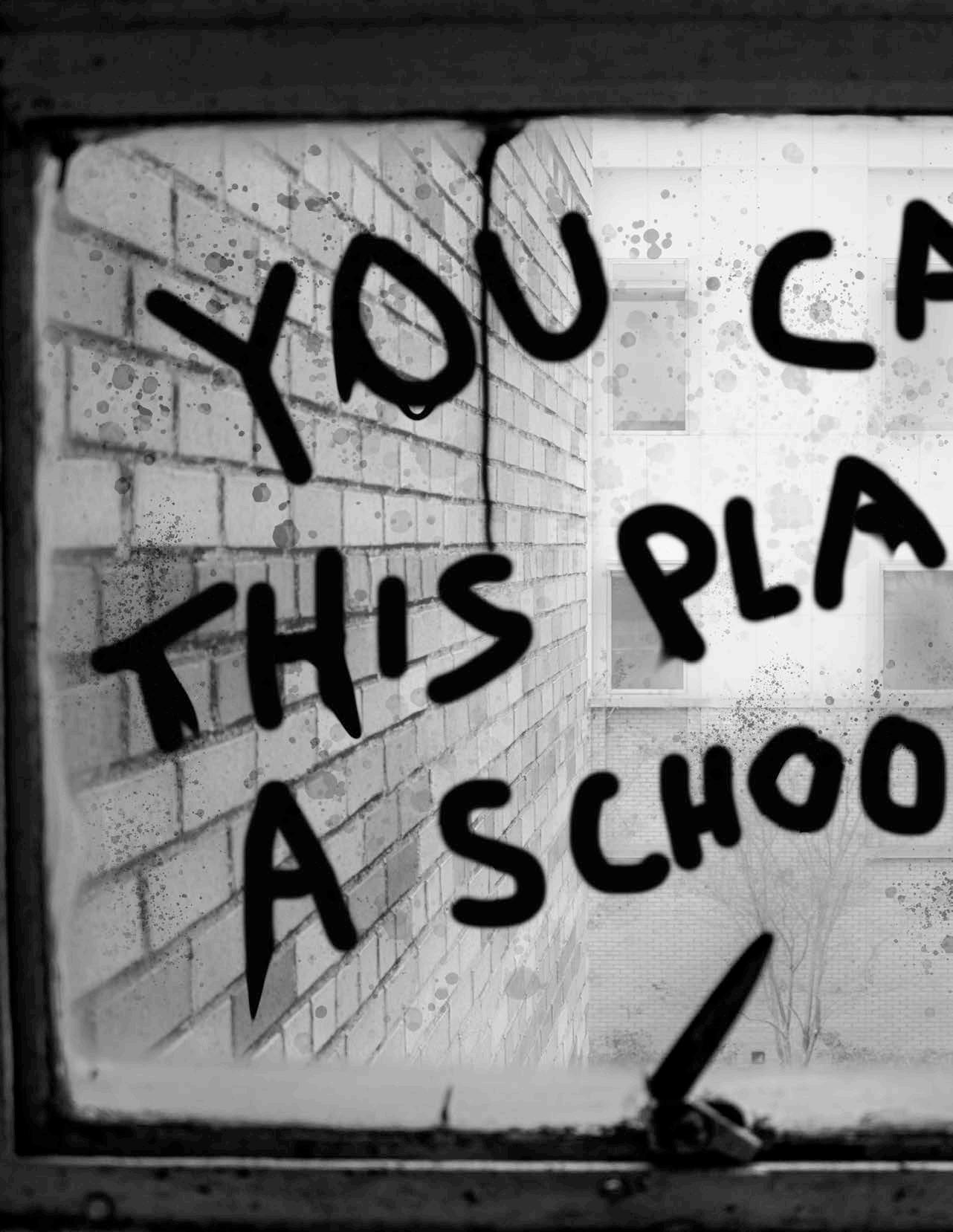
The Fiftieth State
BY CAROLINE FAIREY • PHOTOS BY EVAN DELP • DESIGN BY GRACIE NEWTON
Let me start by saying that I am woefully underqualified to write this article.
I grew up in a small town in the Corridor of Shame, two blocks from the public elementary school. I used to swing and seesaw on the plastic playground that belonged to the local district — until I started going to kindergarten at the local private academy. I’ve never dealt with a lack of classroom resources or an insufficient teacherto-student ratio. And most importantly, because I am white, I have always seen my culture and race affirmed in my history texts, the novels I read, and on the walls and bookshelves of each classroom.
Across the state of South Carolina, even those basic requirements for a quality education have been scarce for decades. We’ve never been known for our stellar public school system, but in 2017, South Carolina’s public schools officially were ranked 50th in the nation by U.S. News & World Report. The Post & Courier called it “another low to South Carolina’s lackluster reputation on schools.” Many educators would call that an understatement.
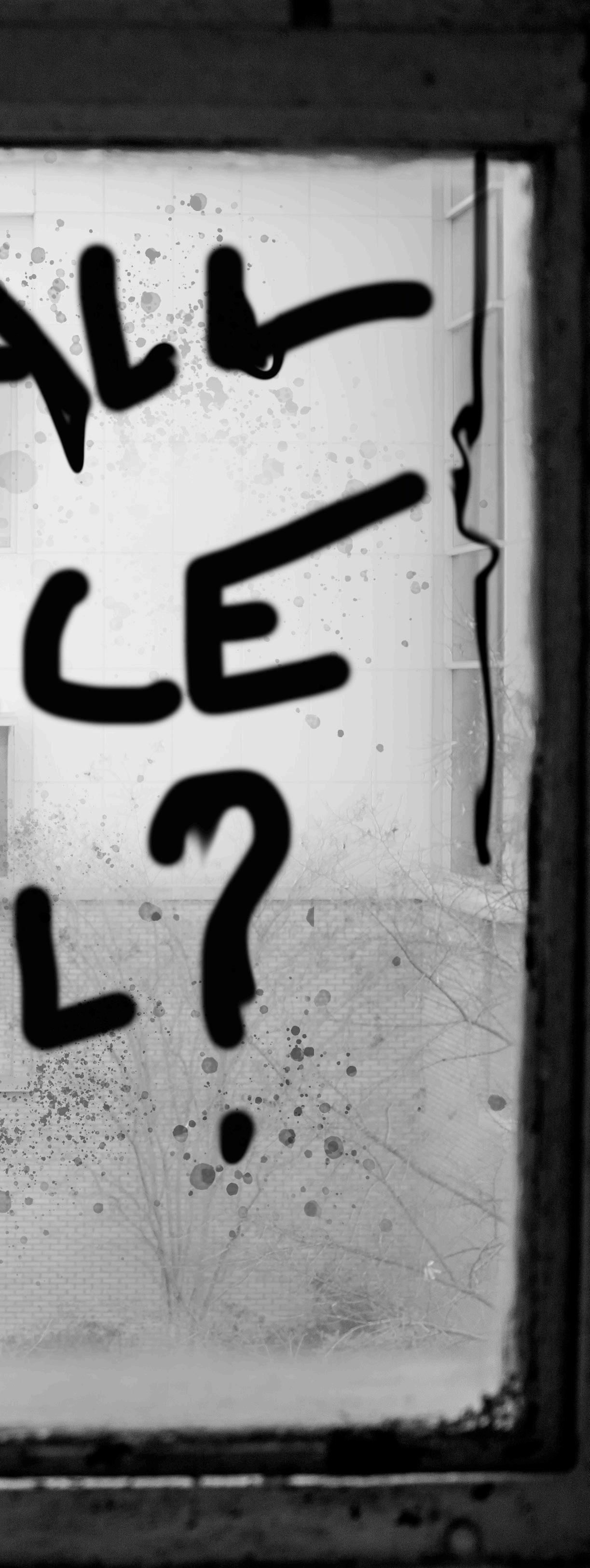
FEATURE 27
How USC-trained teachers can help fix our broken school system.
WHEN BLACK CHILDREN BENEFIT... ALL CHILDREN
The Corridor of Shame became the face of South Carolina’s educational crisis in 2006, when a documentary was filmed onsite in dilapidated classrooms with ancient desks. It focused on the collapse of order and learning in rural schools. On Barack Obama’s 2008 presidential campaign, he made a stop in Dillon, South Carolina to speak at one of the featured schools. A decade later, the schools haven’t seen much improvement, despite new attention.
“There’s a lot of reasons that rural schools suffer,” said Jessie Heinrich, a senior studentteacher who plans to move back to her hometown of Baltimore after graduation. “First, the teachers themselves are overworked and underpaid. It’s an incredibly taxing job, and the budget with which they have to pay you is almost insulting to someone not from the area. You’re also not getting a huge influx of teachers, especially if they grew up somewhere metropolitan — it’s really hard to get someone to move to a rural area when they’re used to an urban one. There’s a lot of teacher burnout
— there’s a program where you can pay off your student loans if you teach in an impoverished area for a certain number of years, but that doesn’t help establish teachers in a school for the long term.”

The University of South Carolina, to its credit, has done its best to distance itself from a statewide reputation of poor academic performance. Even though less than a third of South Carolina eighth graders scored “at or above proficient” in core subjects like math and reading, most USC students enter with a weighted GPA of above 4.0 — mostly As and Bs, in other words. Additionally, although the average range on the ACT for admittance into the USC class of 2016 was 25-30, South Carolina’s average ACT score was 19 — a data point which has particular significance, since South Carolina is one of few states to require every high school junior to take this standardized test.
My central line of question going into this article revolved around whether the university had any responsibility for improving the state school districts. After
all, USC advertises as the flagship public university of our state. It stands to reason that the administration should be looking to serve the public school system, which in turn should be ideally set up to prepare students for the rigors of academics at USC.
But I knew even before I began that racial inequality would turn out to be the real topic of research. USC’s class profile has never been stellar in terms of African American admittance — 10 percent of the Columbia campus population is black, and 15 percent across all USC branches. And yet across South Carolina K-12 public schools, black enrollment accounts for 36 percent of student populations.
“Our overarching goal is to see all children achieve — but specifically African American children rarely see their full potential realized in our state’s and nation’s schools,” said Dr. Gloria Boutte, Founder and Executive Director of USC’s Center for the Education and Equity of African American Students (CEEAAS).
When I sat down to speak with Gloria
BENEFIT.
Boutte and Jennifer Reed (CEEAAS Director), who launched the center last January in coalition with the College of Education, I started by contextualizing my own experience with the Corridor of Shame — as a participant in the historical phenomenon called “segregation academies,” or private schools (which previously had no place in South Carolina) that were founded between 1954 and 1975 to dodge the Brown v. Board of Education ruling. There’s half a century of racist precedent behind hundreds of private schools.
“It’s interesting that you use the word historical, because it’s symbolic of where the problem truly is. We don’t blame the students or the teachers. We look at education structurally in terms of things like funding, teacher preparation for rural or low-income areas, and the content of the curriculum itself,” said Boutte.

In my town — and really, across the state — a variety of excuses continue to rear their heads for why African American students rarely succeed to the level that white students do.
“This difference in achievement has existed since data first started being collected,” said Reed. “Over 50 years of disparity in equity and opportunity for black children. At a certain point, you might call it educational malpractice. How have we not yet managed to address the improvements necessary in this core group of children?”
“People used to refer to this issue as the ‘achievement gap,’ but we don’t like to use that term because it places blame on the student,” Boutte said. “Our programs are focused on outreach to future educators, as well as working hands-on in classrooms. The theme of our most recent conference was Culturally Relevant Pedagogy — Start Where You Are, But Don’t Stop There. Our Early Childhood Education program in the College of Education focuses on issues of equity. The goal is for educators to be prepared to address covert racism and situations caused by it in the classroom; we are here to give them those tools.”
They also addressed the concerning lack of teachers flowing into rural areas of South Carolina. “Our Apple Core Initiative hopes to start recruiting teachers out of high school, especially black teachers, as only 7 percent of teachers nationwide are black. That makes a difference in the classroom for young kids,”
Reed said. “We are prepared to give them support through their years at USC and then three years into their first teaching position. Many people start teaching because they want to make a difference, but the reality of it is that teaching can be much more complex than that. We want to make sure that teachers feel that their concerns are being addressed.”
“When black children benefit, all children benefit,” said Boutte. “It doesn’t do anybody any good to have an inaccurate sense of history. Our motto is, ‘We believe in the power and the possibility of the Black child.’”
This article only can give so much space to the incredible work that the CEEAAS has been doing over the past year. I would encourage everyone, especially future teachers, to peruse their website, read through their pamphlets and ask yourself hard questions about how your educational privilege got you to where you are now. After all, only an educated public can start doing the work to revise and reimagine our state’s policies and values.
29

FIGHTING FOR FEMINISM WHEN YOU’RE NEW TO THE WORKPLACE
THE OTHER “F” WORD
 BY SARAH NICHOLS • PHOTO BY BRENNAN BOOKER • DESIGN BY RACHEL JOHNSON
BY SARAH NICHOLS • PHOTO BY BRENNAN BOOKER • DESIGN BY RACHEL JOHNSON
FEATURE 31
It’s 2018, and we have found ourselves in a revolution of gender equality. No longer are women allowing a blind eye to be turned to the men who grope them on the subways or the coworkers who “harmlessly” make passes at them too many times for comfort. Celebrities once beloved by many are having to reckon with the consequences of their past indiscretions, and their fans are having to reckon with the trauma of losing yet another fallen star in disgrace. And while this most recent revolution started out in the hands of the rich and famous, they have consequently opened up a space for many women to feel courageous and safe enough to share their stories and voice their complaints as well. It turns out — although this likely won’t come as a shock to many — that these goings-on aren’t just limited to the star-studded Hollywood streets; they are pervasive throughout endless industries and workplaces. So as us fellow college students and recent graduates are searching for jobs and entering the workforce, how can we begin our professional careers while ensuring that we are being treated equally and appropriately?
As a student and a manager in a male-dominated field, Julia has had to spend time thinking about and dealing with such issues. Having become only the second female manager of her media company, Julia says that it was much a “boy’s club” before. This workplace culture that she walked into allowed sexual harassment to go un-addressed for some time.
One long-standing member of the company, Lance, made workplace experiences particularly uncomfortable for all of the girls who worked there.
“He would always be making inappropriate comments about women, like one time he yelled at me to ‘suck [his] d***‘ in front of my staff in an interest meeting. He would always make comments if girls come in, like ‘ooh nice tits’ and other comments like that, nonstop,” Julia explained.
They would complain to the male manager, and while he wouldn’t condone Lance’s behavior, he did nothing to stop it..
When a woman, Mia, was hired as manager a few months later, however, the girls of the organization came together yet again to complain. This time, it was heard.
“When we told Mia, she acted immediately. As soon as I had told her about two instances that had happened back to back, the next day she had already called every female staffer and it was done within like a week of her finding out and him being fired,” Julia said. “Whereas the former male manager, we would tell him all the time, and he would be like, ‘well Lance is just an a******’ and it was just because he was very talented. But the female staffers are very talented, too, and a lot of girls left because of it.”
32
What further disheartened many of the girls was that, when they put his firing up to a vote, every girl in the organization voted to fire him, each citing personal accounts of harassment, and every single one of the guys opted not to vote at all, as they felt it wasn’t fair to vote since it hadn’t happened to them.
“That was just a little disheartening to see that a lot of these guys that I’m friends with and I work with wouldn’t vote [to fire] some guy who was a known sleaze-bag,” Julia said.
Workplace culture can become toxic, especially when issues aren’t addressed or handled properly. And since the workforce spends a good portion of their lives surrounded by their coworkers, it’s important that an environment of mutual respect, honesty and equality are cultivated, both for the well-being of the employees as well as the organization’s success.
On the opposite side of the spectrum is Leah Grubb, a USC graduate from the Moore School and a current employee with SAP, a Fortune 500 company.
SAP is a business software solutions company, and probably one of the larger companies that you’ve never heard of. They sponsor a lot of stadiums and sporting events, and they have customers and partnerships such as Coca Cola, Microsoft and IBM. And with their Fortune 500 status, they are rated as a fair work place for women, minorities, and people of varying sexual orientations.
They’re “a forerunner…with the initiative they have to decrease the gender pay gap and gender bias in the workplace,” Leah said. “At SAP, I’ve always had female leadership above me, and that has been an initiative as well. I think they have a boardlevel commitment as well to have a certain percentage of management positions to be women, so they really put out the corporate level commitment to decreasing the gender gap as well as the pay.”
While it might be unrealistic to expect any company to be perfect, what makes SAP’s practices admirable is that they take the initiative to continually ensure that their employees are being treated equally, and, if they’re not, they address the issue immediately.
“I think last year, at SAP, they did a study of their internal pay for their employees, and they were able to find that only one percent weren’t paid equally,” Leah said. “They paid that one percent that wasn’t being paid equally upward pay to make up for it. So
it’s about following up on your actions and holding your company accountable.”
In terms of new employees or those seeking employment, “holding your company accountable” might not seem like an easy or even achievable thing to do. However, Leah emphasizes that one of the best things you can do for yourself in your career is in the interviewing and researching process.
“It’s all in the interview process and being proactive about it,” she said. “And making sure that you’re a culture fit for a company as well, and not just an experience-fit for the job, because you spend so much time at the workplace.”
This means that when you’re doing your research, you’re not just looking into the specifics of the jobs but also the whole environment of the company.
Be “looking more into their culture — what are they doing to empower women? What are they doing to decrease gender bias? And all of that stuff, you know, there should be something on it with that company. If they’re not talking about it, that’s a little red flag,” Leah said.
If you’re a man in the workplace, you might also feel like tough times are ahead of you in terms of workplace culture. However, the most important thing to do in these situations is to listen.
“I think a big thing is listening. Like shutting up and listening,” Julia said. “I don’t want your two-cents on how you think I should deal with it, or telling me to get over it or that it’s not a big deal, because it is, though. And I think, especially, a lot of men don’t realize how normal it is.”
And not only listening, but also elevating both the stories that women are sharing as well as the women themselves.
“Especially if you’re in a position of power, it’s important to help raise those voices that don’t normally have that,” Ivey explained.
And if you are worried about seeming demanding or pushy, don’t let it deter you. Remind yourself of your right to demand fair circumstances, and revel in the term “bossy” as the highest form of a compliment.
People “always blame millennials for asking for too much … but why shouldn’t we be asking that stuff? Why can’t we be asking for more transparency?”
I think Leah has a point.
33
*NAMES
AND ORGANIZATIONS CHANGED FOR ANONYMITY.





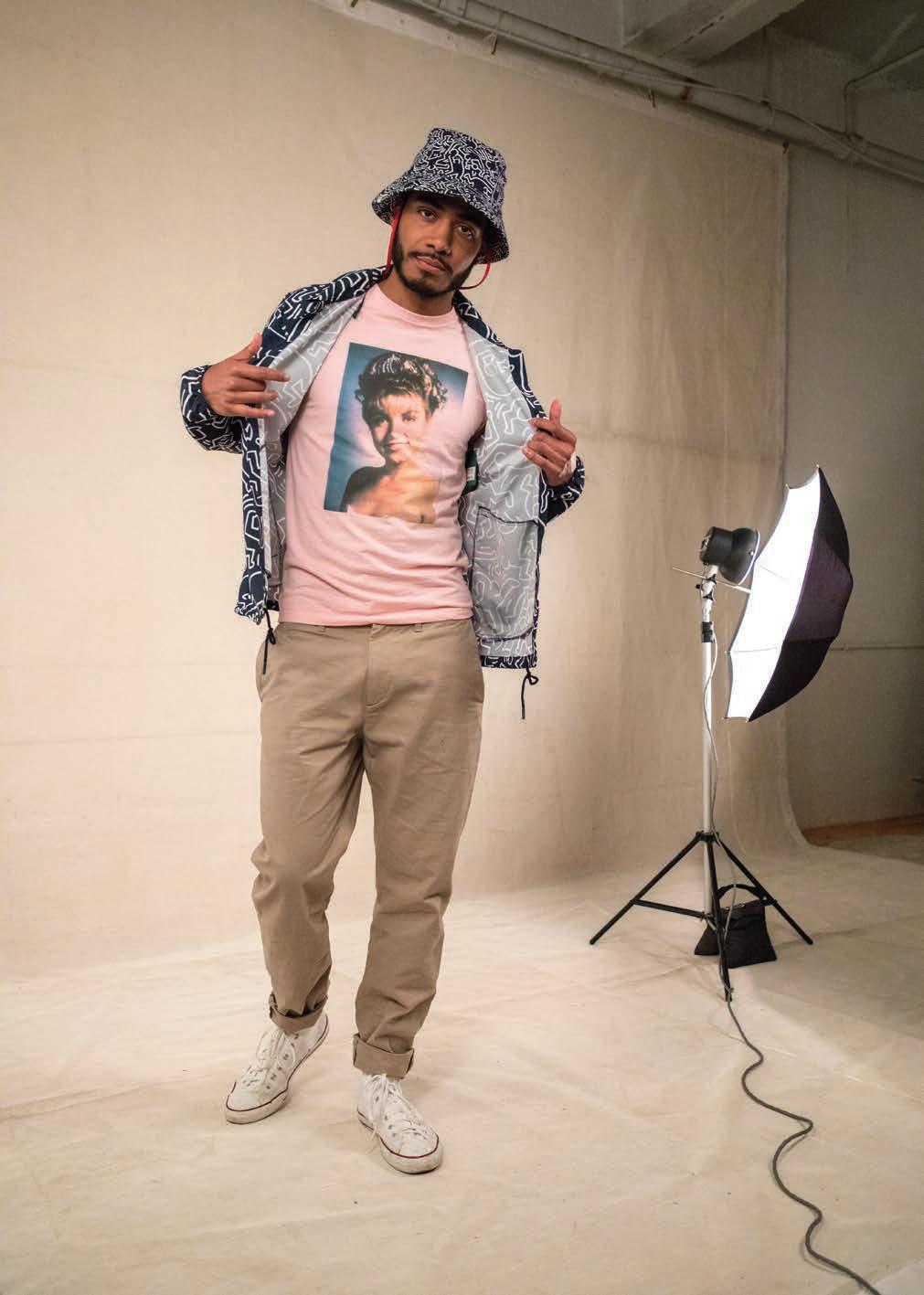 HERS: Nation, Copper Penny, $130 | Ast of Nolta Pants, Vestique, $40 | Shoes, Model’s Own | Pom Pom Earrings, Vestique, $16
HIS: Herschel x Keith Haring Creek Bucket Hat, Bluetile Skateboards, $44.99 | Herschel x Keith Haring Voyage Coach, Bluetile Skateboards, $69.99 | Habitat x Twin Peaks “Laura Palmer” Shirt, Bluetile Skateboards, $19.99 | Khaki’s, Model’s Own | Shoes, Model’s Own
HERS: Nation, Copper Penny, $130 | Ast of Nolta Pants, Vestique, $40 | Shoes, Model’s Own | Pom Pom Earrings, Vestique, $16
HIS: Herschel x Keith Haring Creek Bucket Hat, Bluetile Skateboards, $44.99 | Herschel x Keith Haring Voyage Coach, Bluetile Skateboards, $69.99 | Habitat x Twin Peaks “Laura Palmer” Shirt, Bluetile Skateboards, $19.99 | Khaki’s, Model’s Own | Shoes, Model’s Own






One student’s story of trading her comfortable shoes for 6-inch heels.
 BY ANONYMOUS • PHOTOS BY BRENNAN BOOKER • DESIGN BY RACHEL JOHNSON
BY ANONYMOUS • PHOTOS BY BRENNAN BOOKER • DESIGN BY RACHEL JOHNSON
CULTURE 43
he first time I ever stepped foot in a strip club, I applied for a job. The three o’clock sunshine vanished with the shutting door, and I entered a self-sufficient little world, sealed totally from the outside. All at once it was dark and loud, and I felt the particular way club music jars the body. A man in a three-piece suit led me over garish hotel carpeting to an office just big enough for two standing adults.
“Does your significant other know about this?” he asked me.
“Yes,” I said.
“Your parents?”
“No.”
He checked the appropriate boxes on my papers.
“You’ll start this Friday at 10. At night.” He smiled at me kindly.
For three months during my senior year of college, I drove to work at 9:30 p.m., toting a duffel bag that held, variably, black miniskirts, booty shorts, fishnet stockings, garters, and, always, a white corset and a set of patent black heels. At the club, I would skirt invisibly through a packed nightclub to the locker rooms, where naked women smoked cigarettes and trimmed tampon strings. There I stashed my thrift store jeans and Doc Martens, and picked up a fluorescent serving tray for the night.
I told everyone I was cocktail waitressing at a strip club for the money, which was not totally true, although I suppose I believed it then. My moneymakers were rare anyways, the older men who were from out-of-town and came alone and sat quietly. These were the ones who left me business cards wrapped in hundred dollar bills. Besides those, it was hit-ormiss most nights — the other girls who had been there for years told me business these days was not like it used to be.
I knew when I started that it appealed to me to wear false eyelashes and lipstick to work — to be free to present what beauty I had, without embarrassment, in the most extravagant manner I could manipulate. I was unattractive as a teen, which I shed off by a Spartan force of will when I grew older. I lost loads of weight and learned to draw on my eyebrows and stopped wearing clothes that I liked for those that flattered me. I felt I was almost there, at that pinnacle I had dreamed of for years, but it would not be assured except through trial. At the strip club, I would find proof and validation, once and for all, that I was pretty and desirable, and thus fated to live a happy, fulfilled life. Then, I would stop obsessively watching myself through the selfie camera on my phone or taking videos of my outfits to try and determine how thin I looked to others.
The strip club is built to communicate the desires of men. What he desires and how he will desire it is already laid out, in the most distilled version of the timeless formula for sex. In a strip club, a man knows everything he sees is his, in a
way, if he only asks for it, and then pays. I could see some of my coworkers found this type of frankness rude — I didn’t. When I began work, I felt all the hidden codes of everyday life fall away. I was no longer required to decipher my level of desirability on subtleties and glances and numbers of emojis sent in a text. There was no possibility of misjudgments because of insecurity or extraneous bravado. If a man fanned out ten 100-dollar bills between his hands, and told me I could have them for a lap dance, then my worth was $1,000, which I could, literally, take to the bank. It was addicting. I kept a count of marriage proposals in my head.
The thrill was short-lived. It did not take me long to weary of it, the competition and hustle of it, and something sinister began to surface. Have you ever stayed long enough at a strip club to hear the music cut off and see the lights turn on? A cluster of men cling to the bar — some of them you know had arrived at 9 or 10 and will leave in broad daylight, almost. Dissatisfaction hangs off of them like an odor. You can tell that they are realizing the night is over and nothing has changed, really, from before the night began. Maybe one of the men walks over to you and begins a conversation. You smile but look to move away. He can’t buy any drinks from you anymore, and, anyway, he does not look like the ones that have money. He senses your intentions and quickly throws a few crumbled dollar bills onto your tray to keep you for a moment longer, to maybe tell you how “this kind of place” is not really where he likes to hang out actually, if you really got to know him.
The uneasiness I felt became harder to ignore. I knew it was not just cash that I exchanged with the men at work. Every time, I felt something unnamable seeping from me, an investment I added against my will, which I would never be willing to fulfill. I thought I could work at a strip club and walk away with zero losses, to come and take my fill of adoration, enough to confirm a future potential for love, a love that would have absolutely nothing to do with strip clubs and the men who go to strip clubs. After all, it was the same. Love is a two-sided thing everywhere, even in strip clubs, and life is a series of trade-offs and compromises.
One night, a man stood up in the middle of the club floor and threw a thick stack of ones into the air. I remember stooping at his feet to pick them up, laughing with my coworkers, while the DJ’s voice rang out over a heavy bass, and the strobe lights went spinning. The man who threw the money watched a beautiful woman pole dance naked as more beautiful women scrambled at his feet. Sex and money and power — it was his turn, then, to feel it. Mine would come and go and come again. In the club, everybody got a turn, if only for a moment.
44
THE STRIP CLUB IS BUILT TO
COMMUNICATE THE DESIRES OF MEN

45
FIGHTING FIRE WITH FIRE
What you can say on campus isn’t as simple as it seems.
 BY MARY-BRANT CHARLES ∞ ILLUSTRATION BY ZACH FREHSE ∞ DESIGN BY GRACE STEPTOE
BY MARY-BRANT CHARLES ∞ ILLUSTRATION BY ZACH FREHSE ∞ DESIGN BY GRACE STEPTOE
46 OPINION
THE UNIVERSITY OF SOUTH CAROLINA
cracks the top 10 on a lot of lists. We’ve got the No. 1 Honors College, the No. 1 undergraduate international business major, and we’re ranked third in the world for our sports science program. But there’s another list we’ve got a spot on, one that’s also home to Georgetown, Fordham and Harvard. It’s the Foundation for Individual Rights in Education’s 2017 list of the top ten worst schools in America for free speech.
Free speech is a fan favorite issue in our country, one that we’ve always been willing to step up and ardently defend when the need arises. So where does that need exist at USC? According to the Foundation for Individual Rights in Education (FIRE) our policies on racial discrimination, sexual harassment, and even the Carolinian Creed are guilty of infringements on First Amendment rights; they argue that these policies restrict freedom of speech and conscience. Another part of USC’s constitution the organization criticizes is our policy on what you could call “free speech zones.”
These zones have been implemented at universities all over the country as a way to give students an environment and platform to exercise their First Amendment rights while also allowing the universities to run without interruptions. Others argue that this is the
United States of America, everywhere’s a free speech zone, and to trying to confine it to a designated area violates the Constitution. While USC doesn’t explicitly call them “free speech zones,” there are areas on campus set aside for public demonstrations or solicitation (Davis Field, Greene Street and Pickens Bridge are a few). You have to apply and get the administration’s approval to use them, which only adds to our transgression in the eyes of FIRE. So where does the problem lie? If it’s in our nation’s constitution, don’t we have the right to totally free speech on campus?
No, according to Logic and Ethics
Professor Jim Stiver. “I no longer believe that you have a constitutional right to free speech on campus,” he told me when I sat down with him in January.
Not totally, anyway. He asked me if I thought I had the right to come into his house and insult his wife. I said that I did have the right to do it, but that he’d also have the right and my permission to throw me to the curb. He nodded at my answer, adding, “I don’t think it’s the government’s business to prosecute you for what you said, but if it’s on my property, your rights are curtailed.”
He described a speech he’d seen by Yale Law Dean Robert Post that applies the same logic to free speech on campus. Post argues that in order to serve their purpose — to
educate, to encourage critical thinking and curiosity — universities are within their rights to implement policies like the Carolinian Creed and our sexual harassment policy. Which isn’t to say universities don’t overstep their bounds or overreact in some cases. It’s just their prerogative to do what they can to create an environment conducive to learning. It sounds fair enough, but why do things like free speech zones still draw so much extreme criticism from both sides of the aisle?
The enemy here, in a lot of cases, is precedent. People think that if they allow or regulate free speech in certain instances, the same policy has to be applied to all. Stiver quoted Aristotle in response to this, saying “Justice is treating equals equally and unequals unequally.” Administrations love dichotomies. People love dichotomies. Right and Wrong. Black and White. Freedom and Censorship. It’s a major flaw in how we perceive things, especially issues of free speech. Every case is different, with its own characters and contexts and complications. Its natural to want to find an easier way to process these things, but the case of individuals’ rights is too important. With rights come responsibilities, and our responsibilities as students are to learn and create a place for others to learn.

47
A SOUND OF
BY CAROLINE FAIREY ∞ PHOTOS BY BRENNAN BOOKER ∞ DESIGN BY GRACE STEPTOE
ALL AROUND, SoundCloud artists get a bad rap. Maybe the creation and proliferation of niche genres like electronic folk and indie jazz bothers career music critics, or maybe too many random guys on Tinder include their SoundCloud handle and link their mixtape in their bio.
But for every ill-conceived rap made by rhythmless frat boys, there exists many more genuine, talented artists. Part of the appeal of the platform comes from its accessibility to musicians who live far away from major music hubs and can gain a following online from the comfort of their hometown before they dive in and move to NYC or LA. For example, Toro y Moi grew up in Columbia and went to USC; now, he’s recognized as one of the founders of the chillwave movement. Ten years later, here are two brief encounters with current Soundcloud artists who call Columbia home.
CYBERBAE
Ahomari Turner lives downtown in a sunlit shrine to music and art. They invited me over on one of their rare days off. “We’ve been practicing like crazy lately,” they said, speaking of their upcoming stint for a radio station.
Cyberbae’s music is constantly evolving, but their sound is characterized by their mournful, deep voice, slowbuilding tracks, and lyrical shifts. “My life is music, ever since I was a little kid. If I’m not making music, I’m looking at credits of albums I’m listening to, I’m online looking for instrumentals, or creating instrumentals, or writing lyrics. Music comes before everyone.”
They perform their music in different Columbia venues — some might remember Cyberbae’s intensely emotional set at Hoechella in the fall — but
they also prefer the laissez-faire atmosphere of recording at home. “I post online a lot, but I’m an incredibly private person. My profiles may not look curated — it may look messy as f*** — but it’s because I try my best to make it look as natural as possible.”
They said of their goals for the future: “When I started doing music, I was like, ‘I can’t talk about being queer.’ I’ve never seen anyone like me anywhere in media or doing music, so I had to get comfortable with myself. I’d like to see more people like me performing and doing the creative things they love.”
Cyberbae’s new album dropped on Feb. 1 — catch “4 Black Queers” the next time you’re looking for something contemplative to lose yourself in.
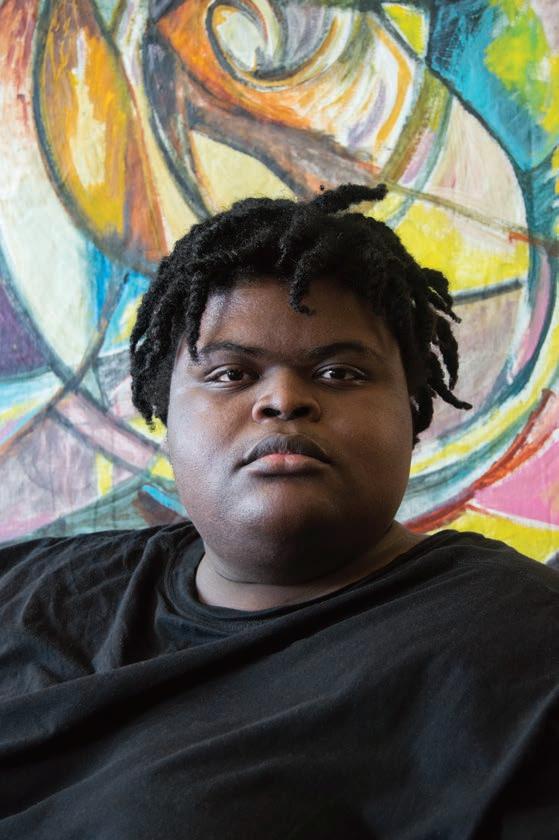
48 MUSIC
THEIR OWN
PLATONIC BAE
Anissa Armaly, Columbiafamous house DJ, plans to move to LA and work in brand consultation. Shockingly, she’s also a senior at USC who “always loved music, but never planned to make [her] own.”

Anissa started off by searching for the intimate house scene in Columbia — a place where she could dance with her friends to good music and avoid the Five Points freshman crowd — and when she couldn’t find something consistent or satisfactory, she started her own series of house shows called Night School and Night Church.
“That’s the coolest thing about Columbia — if someone has an initiative, if they want to start something, there’s a place for them.”
She’s known for her eclectic mixes, championing everything from R&B to the Bee Gees to
Detroit Swindle. About a year ago, she started uploading her mixes to Soundcloud at the request of her friends. She chose the name Platonic Bae “because I’m not afraid to be goofy and intimate. It’s how I love my friends and family, and it’s how I dance.”
Although she doesn’t see a future for herself in music (and actually prefers YouTube for creating spot-on playlists), “Soundcloud will always have a place in my heart. It’s niche, and it’s very receptive and explorative. If someone is genuinely good, there’s the ability to go viral. I hope the business finds a way to stabilize and stick around.”
Anissa often plays on Friday nights in Tapp’s new Space Hall or in other locations around Columbia. Catch her while you can.
49
IN TIME
BY ROBIN
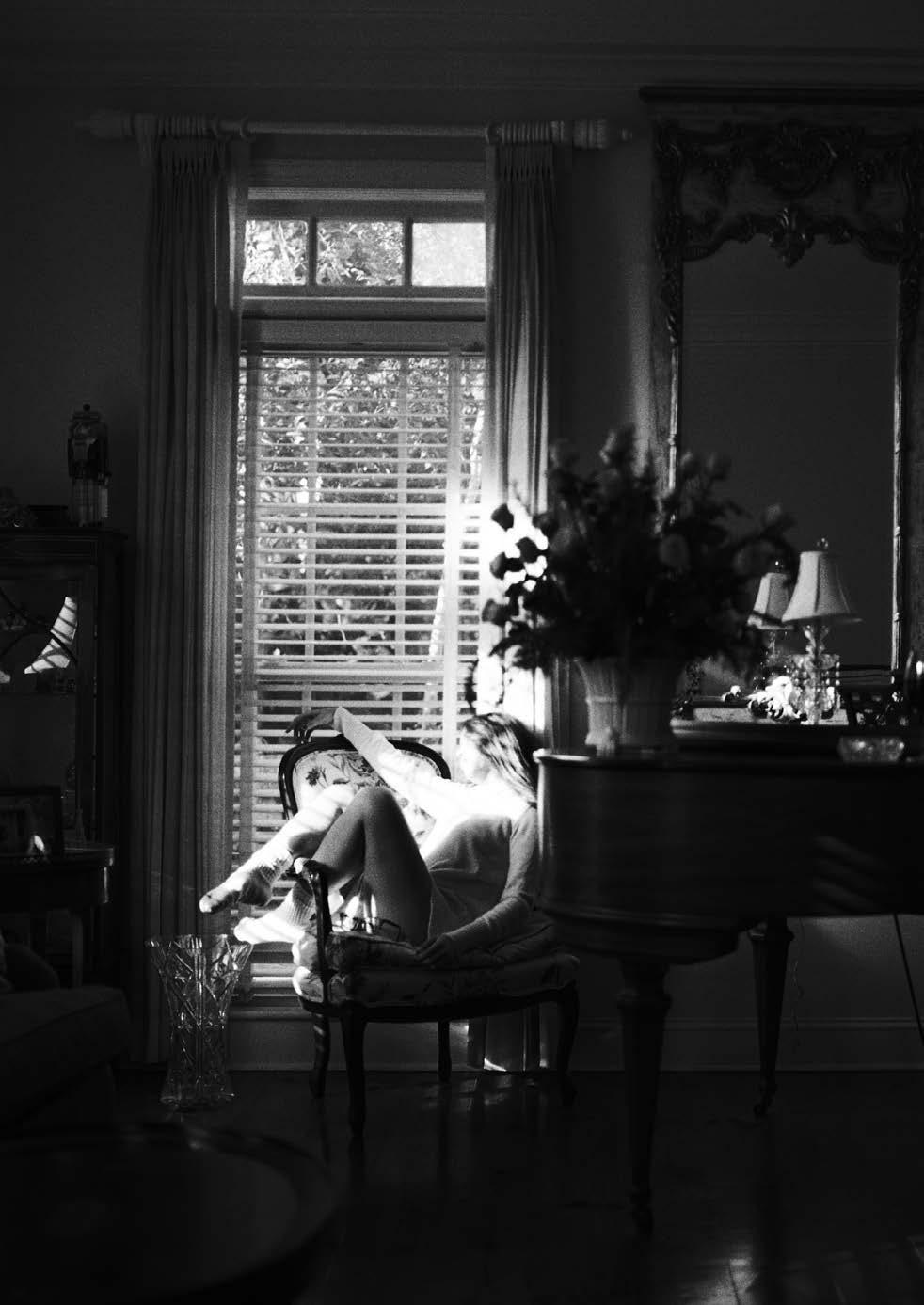
50 FICTION
HENDRICKS • PHOTO BY SAVANNAH TRASK • DESIGN & ILLUSTRATION BY GRACIE NEWTON
The arpeggio sounds so familiar to Allie that it could be silence. She looks down at her hands to where her fingertips press the white keys down with precision. They’re on autopilot, controlled by muscle memory and nothing else. A marionette come to miraculous life. This is the first few minutes of every lesson she’d had since her mother first signed her up 10 years ago. Tennyson stands beside the keyboard, shoulders squared and humming low to match her warm up.
Her mind drifts back to last night, to the smoke-filled rooftop patio with stringed Edison bulbs hanging over the lattice. She was with some friends, trying to listen to their stories. But she was distracted by the beginning melody of “Maggie May” from a man with gray hair playing guitar in the corner. There was a mic nearby, but he wasn’t singing, and a few dollars in change shone silver in his black case. She told her friends she would get another drink, but she stopped by him and listened to the rest of the song. He bent slightly forward over the guitar, looking down at his hands with a vivid awareness of where his fingers landed, where they would go next. He plucked
out the twanging high notes, strummed the harmony. This broke every rule of performance Tennyson had taught her over the years, but the music.
She placed 75 cents into his guitar case during his next break. “That song was nice,” she said.
He took a swig of water, some drops falling down into his beard. “‘Nice’ wasn’t what I was going for, but I’ll take it.”
“I mean,” she said, “it sounded like breathing. I’ve always thought guitars sounded like that.”
“Do you play?” He patted the body of the guitar still hanging from his shoulders.
“No, piano.”
“Ah, percussion. The heartbeat.”
She nodded like she knew what he meant.
“It tells you what the song is about better than any other kind of instrument,” he said, curling his fingers like he was holding drumsticks.
“Sad, happy, thrilled. You know, that zing in your heart when you’re excited about something. When you know this is it.”
It. “I need to get something. Good luck with the rest of the show,” she said, and he
waved her off. Later when she was back sitting with her friends, swirling ice around in her glass and watching it dilute the color, she glanced up again at the guitarist. She could see now that a small smile hid behind his beard, one that came so naturally he probably didn’t even know it was there. Maybe that’s what it is, or at least his it.
“Don’t close your eyes,” Tennyson says, bringing her back into the present moment. She stumbles in her practice set for the first time in a long time, moves back again to middle C. She looks at her hands hovering a half inch above the keys. Her fingers are long and thin, with nails cut short. They’re pianists’ hands, though she isn’t a pianist.
She sets a slower pace than usual, hearing the notes round and whole. The way they connect to each other, bleed together like watercolor paints. Each press of a key is exact, intended. Tennyson isn’t humming anymore.
It feels like a new song beneath her fingertips, even though it’s likely as old as piano itself. If Allie were to name it, she would call it “Curiosity.”
51

VISIT OUR OFFICE OR RELAXJOINFOUNDERS.COM TO COMPLETE YOUR MEMBERSHIP APPLICATION AND RECEIVE A FREE GIFT WHEN YOU OPEN AN ACCOUNT! FEDERALLY INSURED BY NCUA. Services may require credit evaluation. 1 Teens under the age of 18 are required to have an adult sign as joint owner. 2 Accounts without eStatements will be charged $2 for periodic statements by mail. 3 Only members in good standing, with a Checking Account, that meet certain eligibility requirements qualify for this service. Trust, custodial and other fiduciary accounts are not eligible. 4 You must be 18 years or older to qualify for a loan. Qualifications for a loan are based on the credit union¹s criteria, including applicant¹s income and credit history. 5 Surcharge fees may apply when Founders Visa Debit or ATM Card is used outside of the CO-OP ATM network or at non-Founders owned ATMs. foundersfcu.com • 1-800-845-1614 USC DEBIT CARD | FREE CHECKING WITH ESTATEMENTS 1,2 FOUNDERS APP WITH MOBILE DEPOSIT 3 | FREE FOUNDERS ONLINE DIRECT DEPOSIT | SAVINGS ACCOUNTS 1 | SHARE CERTIFICATES 1 LOANS FOR ALL REASONS 4 | ACCESS TO OVER 30,000 SURCHARGE FREE ATMS 5 B.A. MEMBER 12/18 GOOD THRU 4238 1234 5678 9012 3456 UNIVERSITY OF SOUTH CAROLINA DEBIT USC STUDENTS QUALIFY FOR MEMBERSHIP! relax... SM BULLSTREET OFFICE BullStreet Neighborhood 2166 Boyce Street UNIVERSITY OF SOUTH CAROLINA OFFICE Russell House University Union 1400 Greene Street, Room 227 U KILLIAN ROAD OFFICE (COMING SOON) 80 Tulip Oak Drive
Aubade for Lonely River
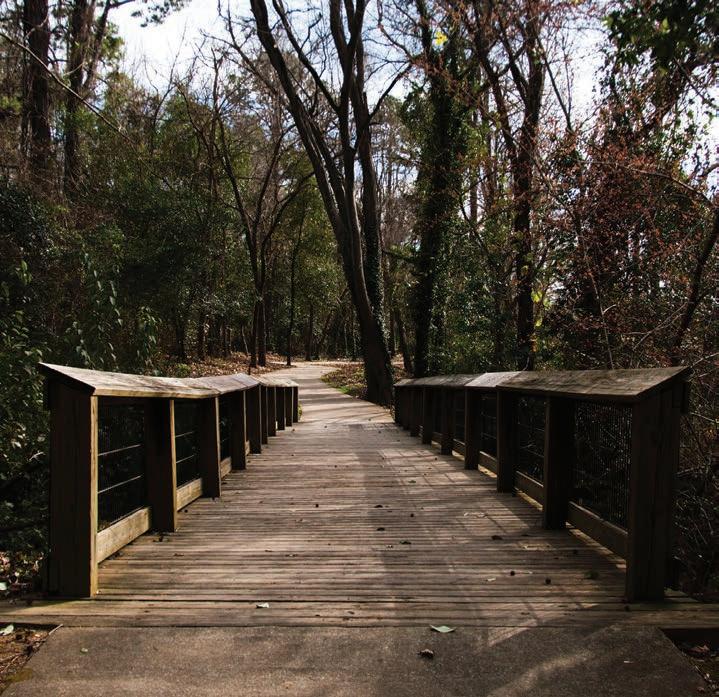 ANNA SHEPPARD
ANNA SHEPPARD
Moaning, the river wakes. Her greyed current strokes the boulders, combing algae off in flakes like pulling dried mud from a wrestling child’s knotted head. Her breathing you barely miss — the way music played from a neighboring room comes off blanketed, foreign, all those lyrics we lose to the weight of the wallpaper. What I’m saying is maybe we’re missing something in the river’s language, maybe her lyrics, tossed from bank to bank, become bait for the bowfin, and maybe their scales have secrets they don’t want the silence to share. Maybe I think too much of this. But haven’t you heard the trees grow anxious in their whispers? Don’t the branches scold? How naïve to believe we are the only ones with stories to tell, the only bodies whose sentiments pin themselves to our sleeves. Hear the way the leaves, long dead, fly up and around each other, and you’ll hear a corpse’s only wish: to not be buried beneath another. Listening, I drop a stone in the Congaree’s mouth. One moment, her esophagus is heavy with its gulping; the next, a chorus begins.
Morning dew on denim, I lean back into the cold blanket of the cement’s early sweat. The stick of it traces my spine, my ribs, and I imagine dissolving into it, the grey rock gradually reaching around my bones until my body becomes memory, my voice becomes dream. I left you knee deep in the river to scale the scorned stature of the viaduct that, left in the heat, begs the trail to take it in. The Riverwalk obliges: moss takes to concrete
like ink poured on a blank page, the cool crunch of it filling the plant’s open mouth. Sitting, I scrape and scrape until my nails are browned with the swampy stain. You call up from the river and the distance turns your voice stranger. Lost cause, you say — well, let it be lost. Let nature’s appetite consume, and let her thirst swallow this haunted track whole. Let the vines take heart in their journey, smoothing up the tracks slow, like moccasins called by their god back to the sky.
Soon we cannot stay. Soon the day will open her heavy doors and our bothered lives will be on their way, tripping with the weight of everything we didn’t mean to carry. Meanwhile Congaree’s currents continue. Water folds into water, an origami of melted patterns we can’t begin to replicate, her dimensions different than our own, here, where there are one hundred versions of above and beside, even more of below. A fish leaps from her tide and immediately falls again, like something beyond gravity waits pulls her to the floor. We cannot stay, though all she asks is our company: no understanding, no burden of the way our science turns beauty into handwriting, turns her language into latitudes. The sun has risen now, its homebound rays making a million little mirrors out of every crease in the river’s surface, a million little ways you can watch yourself burn and bide, whither and wake, but we say it again, say it until the wind grabs our words by their collars and carries them to the coast: we cannot stay, we cannot stay.
POETRY 53

NATALIE, 20 The “my love life is epic enough so I need a method with no drama” birth control. Fees for extra services requested or required are not covered by WhoopsProofSC. Valid only for students at participating colleges & universities in South Carolina thru 12/31/2018. Schedule an appointment to review your eligibility. The Implant. Now FREE or low-cost. Stop by the USC Center for Health & Well-Being or visit whoopsproofsc.org.
BY ABBY BEAUREGARD PHOTOS COURTESY OF TAPPS DESIGN BY KATIE SLACK
WHILE THERE ARE SPACES for artists in the university community, after graduation, students often struggle to find ways to continue their creative passions without as many resources as they had access to while still in school.
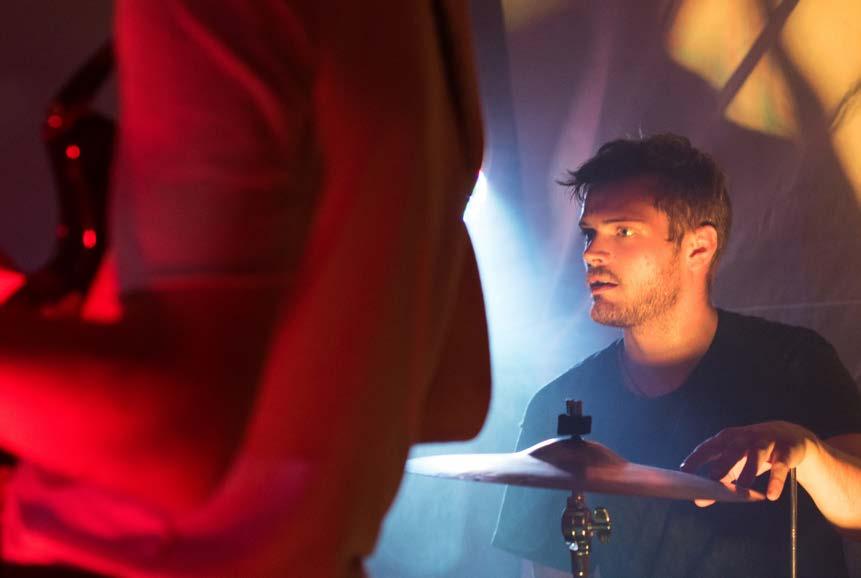
Art centers such as Tapp’s are hoping to change that with new projects such as their Space Hall initiative. Space Hall is a new, raw, collaborative space that its founders are hoping will help bridge the gap between artists, especially photographers, and resources within the Columbia area.
Members of the public will be able to buy time to use the space as a backdrop for photoshoots or to develop photos in the new darkroom. In other words, creating art that can then be exhibited on the walls upstairs.

Space Hall isn’t just for photographers, though. Its goal is to be a creative a space for artists to network and collaborate in ways they may not have previously had access to. The studios at Tapp’s are filled with jewelry designers, painters and sculptors who can all stand to benefit from each other in unique and exciting ways.
There is also hope that the raw space can be used for events such as galleries or parties to further foster a sense of community that the Columbia art community could benefit immensely from.
For more info about Space Hall and its events, find them on Instagram at @the.space.hall. of.cola.
I KNOW A PLACE
VENUE 55
Strom Thurmond Wellness & Fitness Center Solomon Blatt Physical Education Center


P: 803-576-9375
F: 803-777-5261
campusrec.sc.edu
University of South Carolina Campus Recreation



@UofSC_CampusRec
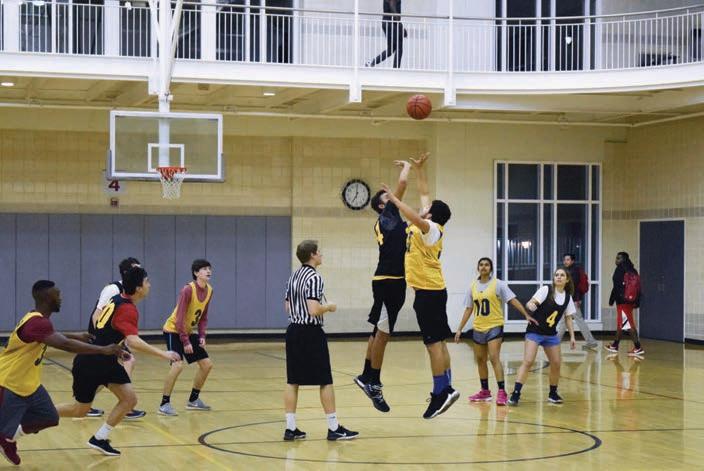
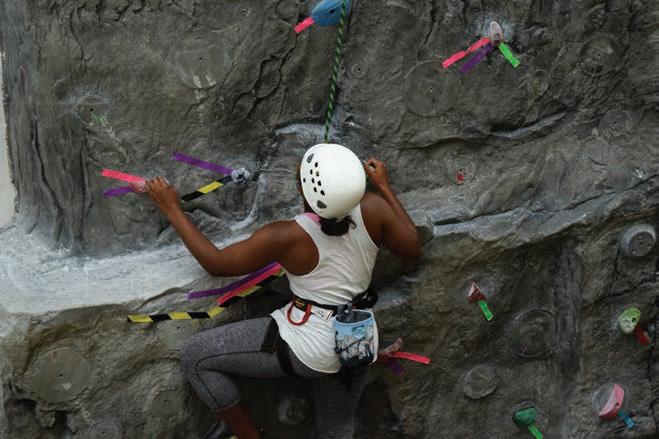

Outdoor Recreation Sport Clubs Aquatics Personal Training Intramural Sports Group Exercise Bike Shop









































































 BY CHRISTIAN COMPTON • PHOTOS BY EVAN DELP • DESIGN BY ANGEL PRATER
BY CHRISTIAN COMPTON • PHOTOS BY EVAN DELP • DESIGN BY ANGEL PRATER















 BY SARAH NICHOLS • PHOTO BY BRENNAN BOOKER • DESIGN BY RACHEL JOHNSON
BY SARAH NICHOLS • PHOTO BY BRENNAN BOOKER • DESIGN BY RACHEL JOHNSON





 HERS: Nation, Copper Penny, $130 | Ast of Nolta Pants, Vestique, $40 | Shoes, Model’s Own | Pom Pom Earrings, Vestique, $16
HIS: Herschel x Keith Haring Creek Bucket Hat, Bluetile Skateboards, $44.99 | Herschel x Keith Haring Voyage Coach, Bluetile Skateboards, $69.99 | Habitat x Twin Peaks “Laura Palmer” Shirt, Bluetile Skateboards, $19.99 | Khaki’s, Model’s Own | Shoes, Model’s Own
HERS: Nation, Copper Penny, $130 | Ast of Nolta Pants, Vestique, $40 | Shoes, Model’s Own | Pom Pom Earrings, Vestique, $16
HIS: Herschel x Keith Haring Creek Bucket Hat, Bluetile Skateboards, $44.99 | Herschel x Keith Haring Voyage Coach, Bluetile Skateboards, $69.99 | Habitat x Twin Peaks “Laura Palmer” Shirt, Bluetile Skateboards, $19.99 | Khaki’s, Model’s Own | Shoes, Model’s Own






 BY ANONYMOUS • PHOTOS BY BRENNAN BOOKER • DESIGN BY RACHEL JOHNSON
BY ANONYMOUS • PHOTOS BY BRENNAN BOOKER • DESIGN BY RACHEL JOHNSON

 BY MARY-BRANT CHARLES ∞ ILLUSTRATION BY ZACH FREHSE ∞ DESIGN BY GRACE STEPTOE
BY MARY-BRANT CHARLES ∞ ILLUSTRATION BY ZACH FREHSE ∞ DESIGN BY GRACE STEPTOE





 ANNA SHEPPARD
ANNA SHEPPARD










